The emergent discourse on evaluation roots for methodological pluralism and innovative approaches to evaluation. This calls for designating the purpose of
evaluation as ‘explaining the impact’ rather than ‘providing evidence of the impact’. Shaped by systems thinking and complexity theory, alternative approaches
to evaluation focused on improving development practice are acknowledged as the way forward.
Evaluating Communication for Development is a comprehensive treatise on the present day evaluation discourse with the perspective communication for development (C4D) for social change. The book provides a perspective on C4D, social change, evaluation of social change and evaluation capacity building from a
systems and complexity lens. It provides clarity on the various terminologies, principles, concepts and introduces to a range of approaches, methodologies and
methods that could be considered while evaluating C4D interventions. While doing so, it critiques the dominant approaches viz. the logframe as simple, linear and
cause-effect reduction of complex social systems and at the same time, provides an overview of current trends in evaluation thinking. It advocates for participatory
approaches like ethnographic action research that promote downward accountability for evaluating C4D imperatives while focusing on power relations,
gender and social norms.
Located in the discourse, it articulates a comprehensive framework for evaluating C4D for social change, the framework itself being a synthesis of approaches
including developmental evaluation. The framework with its seven components— participatory, holistic, complex, critical, emergent, realistic, learning-based and
related principles is considered sufficient in answering the evaluation questions to be responded in such C4D interventions. The book reiterates movement past the
paradigm wars towards mixed methods for explaining the change rather than proving the change such that the practice is improved.
Alongside personal experiences and reflections, discussion on principles and concepts is embedded in comprehensive review of literature that points an interested reader towards directions for further explorations. However, treatment of C4D and evaluation is in the perspective of donor driven international development and that of large-scale state fostered mainstream C4D interventions is not integrated. Also, a more coherent structure would have enhanced readability. The framework is introduced too soon while implementation of the framework is part of the conclusion chapter with only half the chapter discussing the same. While the book comes as a ready reckoner on emerging evaluation discourse and evaluation of C4D, it would appeal more to students, researchers and academics than practitioners.



Leave a Reply
Your email address will not be published. Required fields are marked (required)
You must be logged in to post a comment.